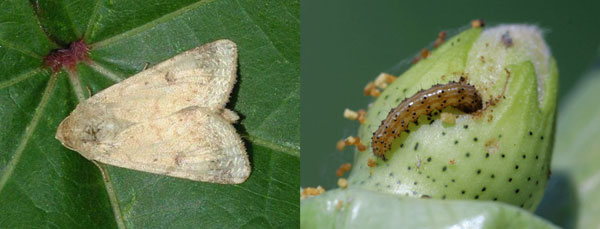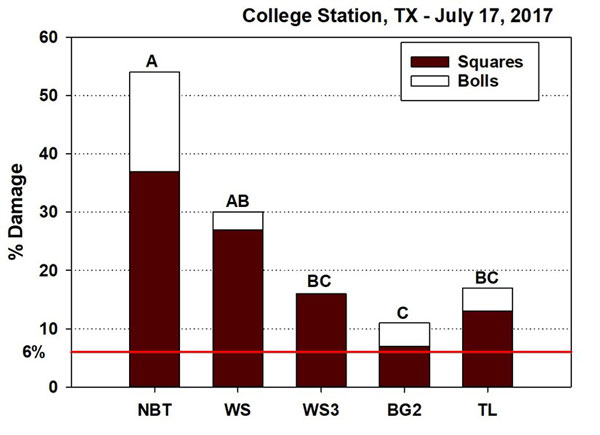Cotton bollworm (a.k.a. corn earworm, sorghum headworm, or soybean podworm) has been responsible for significant losses in the early years of Kansas cotton production and still has the potential to be a serious pest. Recently, damage has been limited in Kansas with the common usage of Bt cotton (Bollgard II® and WideStrike™) varieties. However, bollworm resistance to currently used Bt traits has been documented in other states. Producers should monitor fields even if Bt products appear to be working well in the area.
Scouting for bollworms
Adults are medium-sized, cream-colored moths that are seen frequently throughout the day during periods of heavy infestations (Figure 1). Moths deposit eggs individually, usually on young terminal leaves but sometimes on leaves and squares within the canopy. Eggs are the size of a pinhead, white to cream in color, and hatch in two or three days during warm weather. Young larvae are difficult to find until they are three or four days old. At this stage, they are about ¼ inch long and brownish with some scattered hairs (Figure 1).

Figure 1. Adult moth (left) and bollworm larvae (right). Photo courtesy of J.P. Michaud, K-State Research and Extension.
The full-grown larva is about 1½ inches long with a light-colored head capsule. The predominant body color may range from pink or green to various shades of tan or dark brown. A series of dark stripes run lengthwise on the body. Larvae begin feeding on leaf tissue and small squares, then move down the plant and damage the larger squares and bolls. Bollworm management is based on scouting for eggs or small larvae. Thresholds differ for bollworm-resistant and boll-worm susceptible cotton. Treatment for non-Bt cotton is recommended when 10 eggs or five small worms per 100 plants are present during early bloom in late July and early August. Treatment for Bt cotton is recommended if fruit and boll damage is excessive, as indicated by 10 small worms (¼- to ⅜-inch long) per 100 plants or six small worms in 100 flowers.
Control options for bollworms
The use of Bt cotton (Bollgard II® and Widestrike™) is common in Kansas. However, it is important to note that bollworms must ingest the Bt toxin to be killed, and it may take up to five days from the time of ingestion to death. After ingesting the toxin, susceptible larvae lose their appetite and stop feeding within a few hours. However, bollworm resistance to currently used Bt traits has been documented in other states (Figure 2). Rates of bollworm survival increase as larvae mature and exceed ½-inch long or five days old.

Figure 2. Bollworm injury to cotton near College Station, TX in 2017. NBT = Non-Bt, WS = WideStrike™, WS3 = WideStrike II™, BG2 = Bollgard II®, TL = TwinLink®. *The red line represents the economic threshold. Source: https://agrilife.org/texasrowcrops/2019/03/18/developing-resistance-to-bt-genes-in-cotton-bollworm/.
Preventative treatments applied during the pre-bloom period are discouraged because they can destroy beneficial insects (i.e., natural predators), which help keep bollworms and other pests under control. Chemical control (Table 1) is rarely effective after larvae exceed ½ inches in length (five days old, third instar). Once cotton has blooms within four to five nodes of the top of the plant (i.e., cutout), the need for bollworm control has usually passed.
The value of late-season treatments depends on the weather. Because of the relatively short growing season for cotton in Kansas compared to most of the US Cotton Belt, late blooms can add little to final yields in most cases. Because of this, late-season treatments are usually not justified unless populations are heavy and the weather remains favorable.
Table 1. Insecticides labeled for bollworm control in cotton3. Source: Cotton Insect Pest Management 2024, K-State Research and Extension.
|
Chemical Name |
Product(s) |
|
Acephate |
Acephate, Bracket, and Orthene |
|
Acetamiprid |
Intruder and Assail (used as an ovicide) |
|
Alpha-cypermethrin |
Fastac CS (2.6 to 3.6 fl. oz./acre) |
|
Bacillus thuringiensis |
Biobit, Deliver, Dipel, Lepinox, and Xentari1 |
|
Beta-cyfluthrin |
Baythroid XL |
|
Bifenthrin |
Numerous products, including Annex, Bifenthrin, Brigade, Discipline, Empower 2, Fanfare, Sniper, and Tundra |
|
Bifenthrin + abamectin |
Athena |
|
Bifenthrin + chlorantraniliprole |
Elevest |
|
Bifenthrin + imidacloprid |
Brigadier and Tempest |
|
Bifenthrin + zeta-cypermethrin |
Hero |
|
Chlorantraniliprole |
Vantacor |
|
Chlorpyrifos |
Multiple products |
|
Chlorpyrifos +lambda-cyhalothrin |
Cobalt Advanced |
|
Chlorpyrifos+zeta-cypermethrin |
Stallion |
|
Cyfluthrin |
Tombstone |
|
Cyfluthrin + imidacloprid |
Leverage |
|
Cypermethrin |
Ammo |
|
Deltamethrin |
Delta Gold |
|
Endosulfan |
Endosulfan, Phaser and Thionex |
|
Esenfenvalerate |
Asana XL |
|
Fenpropathrin |
Danitol |
|
Gamma-cyhalothrin |
Proaxis |
|
Imidacloprid |
Alias 4F, Couraze Max 4F, Trimax, and Wrangler |
|
Indoxacarb |
Steward |
|
Lambda-cyhalothrin |
Numerous products, including Warrior II with Zeon Technology, Silencer, Taiga Z, and Lambda T |
|
Lambda-cyhalothrin + chlorantraniliprole |
Besiege |
|
Lambda-cyhalothrin + thiamethoxam |
Endigo ZC |
|
Methomyl |
Lannate LV and Lannate SP |
|
Methoxyfenozide |
Intrepid |
|
Naled |
Dibrom |
|
Novaluron |
Diamond |
|
Profenofos |
Curacron2 |
|
Spinosad |
Entrust, Blackhawk |
|
Thiodicarb |
Larvin |
|
Zeta-cypermethrin |
Mustang MAXX. etc. |
1Products containing Bt should not be used on Bt cotton or its refuge.
2Curacron and Lannate may be phytotoxic to cotton under stress and may redden cotton.
3For use rate and any other information relative to any insecticide listed in these tables, ALWAYS consult the actual label on the product.
Other late-season insect pests: Stinkbugs
Several types of stinkbugs can feed on cotton. Stinkbugs have piercing-sucking mouthparts that they use to feed on cotton bolls by piercing them and feeding on developing seeds, which can lead to decreases in yield and fiber quality. Stink bug feeding can result in warts inside the boll and stain fibers. Feeding by stinkbugs can also transmit pathogens that cause boll rot. Action thresholds are based on injury and not on insect counts. Action thresholds are 10-15 percent boll injury during weeks 3-5 of bloom, 20 percent during weeks 2 and 6, and 30 percent or more 7 or more weeks after bloom.
For more information on insect pest management in cotton, see the 2024 Cotton Insect Pest Management bulletin available from the KSRE Bookstore: https://bookstore.ksre.ksu.edu/item/cotton-insect-pest-management-2024_MF2674
The use of trade names is for clarity to readers and does not imply endorsement of a particular product, nor does exclusion imply non-approval. Always consult the insecticide label for the most current use requirements. Users should read and follow all label directions.
Logan Simon, Southwest Area Agronomist – Garden City
lsimon@ksu.edu
Anthony Zukoff, Extension Entomologist – Garden City
azukoff@ksu.edu